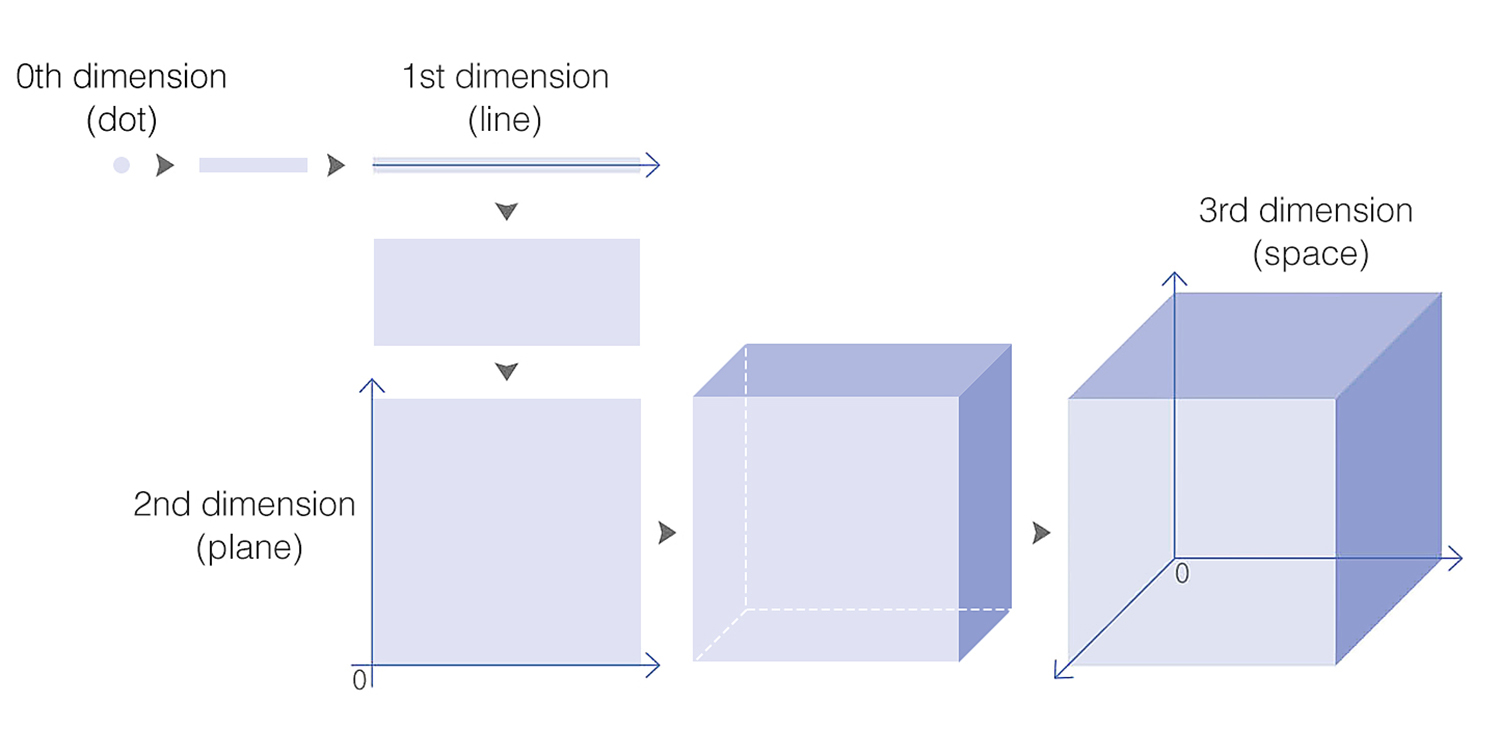They say “Dimensions are different” when something goes beyond their expectancy or when something is not understandable. In such cases, a dimension means a particular aspect of something or a way of considering it.
However, there is another definition of dimension. In the mathematical sense, it refers to spaces like a two-dimensional plane or a three-dimensional cube. Interestingly, however, in terms of recognizing dimensions, we can say that we are in a “low dimension.” Just as the beings in the two-dimensional world cannot know the three-dimensional world accurately, we cannot perceive the higher-dimensional worlds in the three-dimensional world that we see.
Then how many dimensions are there in the universe? There can be a new dimension in the universe that is completely different from the dimension that we can perceive. So mathematicians and physicists have been trying to understand the universe by introducing various dimensions.
Dimensions that we can perceive
Dimension refers to the number of coordinate axes required to represent the position of points in space in mathematical physics. The vertical line, coordinate plane, and coordinate space that we learned step by step in mathematics are the mathematical representations of the dimension. This is explained by physical quantities such as length, area, and volume.

The zero dimension represented by a dot has no length, area, or volume. Therefore, there is no coordinate axis that can indicate the position. There is only one axis in one dimension. It has length but no area or volume. The position on the straight line is displayed in one coordinate only. Two dimensions are a plane. They have length and area, but no volume. The position on the plane is indicated by the coordinate value that crosses from the horizontal axis and vertical axis. The three-dimensional space has a length, an area, and a volume, and the position can be represented by the coordinate value from three axes—the horizontal axis, vertical axis, and one more axis which is perpendicular axis.
The new concept, which emerged from Einstein’s theory of relativity, is the concept of four-dimensional space-time. Four-dimensional space-time includes a physical quantity of time as another dimension in three-dimensional space. In the past, scientists thought it was pointless to include the coordinate axis of time in three-dimensional space because they thought that time flows equally everywhere. However, as the theory of relativity was published, the view of time began to change.
According to the theory of relativity, time flows differently for the objects that are fast enough to almost reach the speed of light or in space with great gravity like a black hole, and time and space are connected to each other. Thus, the axis of time could become a coordinate value with a new meaning by the theory of relativity, and we could think about the four-dimensional space-time.
A world of higher dimensions that we cannot perceive
Edwin Abbott explains dimensions figuratively in his novel, Flatland: A Romance of Many Dimensions. It is about the Square that lives in Flatland, the two-dimensional world. He visits Lineland, the one-dimensional world, and Spaceland, the three-dimensional world, and Pointland, where there is no dimension, and talks with the people of each land.
People in each land are persuaded that their land constitutes the whole of the world, and understand everything according to the principle of their land. For example, the Square visits Lineland and tries to explain the existence of Flatland, a higher-dimensional world, to the people there. However, the people in Lineland who understand “front” and “back” but have never heard or even imagined “right” or “left” do not believe what the Square says. The Square goes to Spaceland and thinks of it as a mysterious world, seeing things like “up” and “down” for the first time.
As in the novel, beings in the lower dimensions cannot fully understand the higher dimensions. How would the beings in the one-dimensional world where there are only lines understand the areas of the two-dimensional world and the space of the three-dimensional world? The creatures that live in the two-dimensional world will find it impossible to understand the creatures that live in the three-dimensional world which has a new space called “height.”
Moreover, it is too early to say that our questions about the three-dimensional space and the four-dimensional time-space have been solved completely.1 The last part of the movie Interstellar impressively depicts a higher-dimensional world which we cannot perceive, based on scientific theories and infinite imagination. It is a scene where the father who enters a higher dimension through a black hole meets his young daughter of the past in her room. Those who watched the movie probably felt anxious when the father can see his daughter, while the daughter cannot see her father. She doesn’t notice the message her father tries to relay to her; she can’t recognize her father who is in a higher dimension, because she is stuck in the three-dimensional space.
1. The world we live in is usually expressed as a three-dimensional space, and it is sometimes referred to as a four-dimensional space-time where time is added to the three-dimensional world according to Einstein’s theory of relativity.
Time travel in the fourth dimension once became a big issue. Although novels and movies often deal with the subject of time travel, many physicists say that time travel in the four-dimensional space-time is almost impossible. For example, let’s say Person A travels to the past. Can Person A in the past and Person A in the present exist in the same time and space? It is against the laws of physics that two objects cannot occupy the same space at the same time.2
2. If two objects exist in the same space at the same moment, all the laws of physics fail, including the basic law of conservation of mass-energy that the sum of the total mass and energy of the universe is always constant.
Imagining a higher-dimensional universe

Picasso’s painting Guernica is interesting. His method to express a three-dimensional structure on a two-dimensional plane is unique. People in this painting have both the front of their faces and their profiles, or the back of their heads and the front of their faces. He embodied a four-dimensional space on the canvas by drawing each area of the structures he observed at various angles. Along with the three-dimensional appearances that cannot be expressed in the plane, it seems to contain invisible pain and desperation. Picasso became the best artist of the 20th century thanks to his imagination surpassing the dimension.
Human senses can experience only up to the third dimension. As we are trapped in a three-dimensional space, we can easily understand the zero-dimensional, one-dimensional, and two-dimensional worlds, but we can’t grasp higher-dimensional worlds directly. It is impossible to understand higher dimensions with three-dimensional thoughts. It may be because all our levels of understanding and physical laws satisfy only the three-dimensional world.
With the exception of the unknown dark matter and dark energy whose existences have been inferred from the rotational speeds of galaxies and the accelerating expansion of the universe, the universe we can perceive is merely four percent. In order to clear up phenomena in the universe that cannot be fully explained by three-dimensional laws of physics, physicists have come up with the notion of dimension; they began to look at the universe with the viewpoint of Picasso. String theory3 and M-theory4, which were suggested to solve gravity, the biggest assignment of physics, and to complete Unified field theory5, explain that the space-time is composed of high dimensions up to ten or eleven dimensions. These theories view elementary particles as the vibration of a string or a membrane. Although they are unproven hypotheses, there are possibilities.
3. String theory explains that the minimum unit in nature is not a point, but a string that vibrates. It explains that the nature of particle and the basic force of nature are determined by the shape and vibration of the strings. It is also called superstring theory.
4. M-theory unifies all five versions of superstring theory in eleven dimensions mathematically. It explains that the nature of material is membrane. This is why it is called M-theory.
5. Unified field theory attempts to integrate the four fundamental forces that exist in the natural world—gravity, electromagnetism, strong, and weak as one. Electromagnetism, strong, and weak have been unified in the microscopic world, but gravity which exposes its existence only in the macroscopic world has not been unified yet. Theories that have emerged to explain this are string theory and M-theory.

With the concept of dimension, we might be able to explain the universe that we cannot understand with our senses and supernatural phenomena that we cannot comprehend with our cognitive ability. Now we perceive the vast universe as a three-dimensional world, but the deep universe must overflow with images and phenomena that we do not understand.
We are bound in the three-dimensional space. The world beyond it is unfathomable. How can we see that world? Who can tell us about that world?
I know a man in Christ who fourteen years ago was caught up to the third heaven. Whether it was in the body or out of the body I do not know—God knows. 2 Co 12:2
Oh, the depth of the riches of the wisdom and knowledge of God! How unsearchable his judgments, and his paths beyond tracing out! Ro 11:33
For every house is built by someone, but God is the builder of everything. Heb 3:4